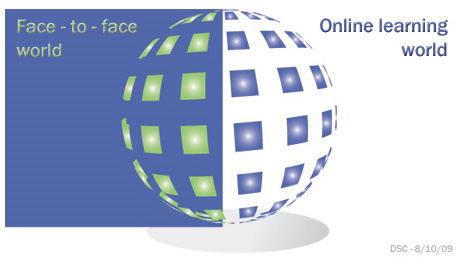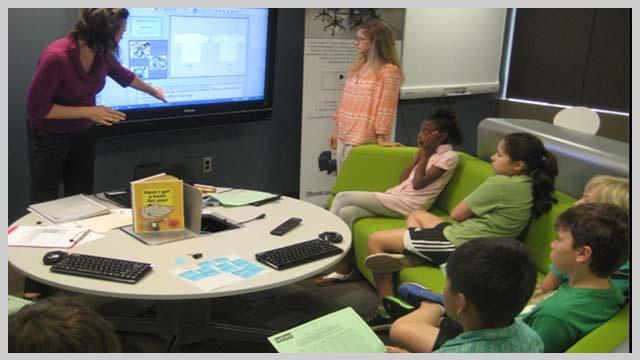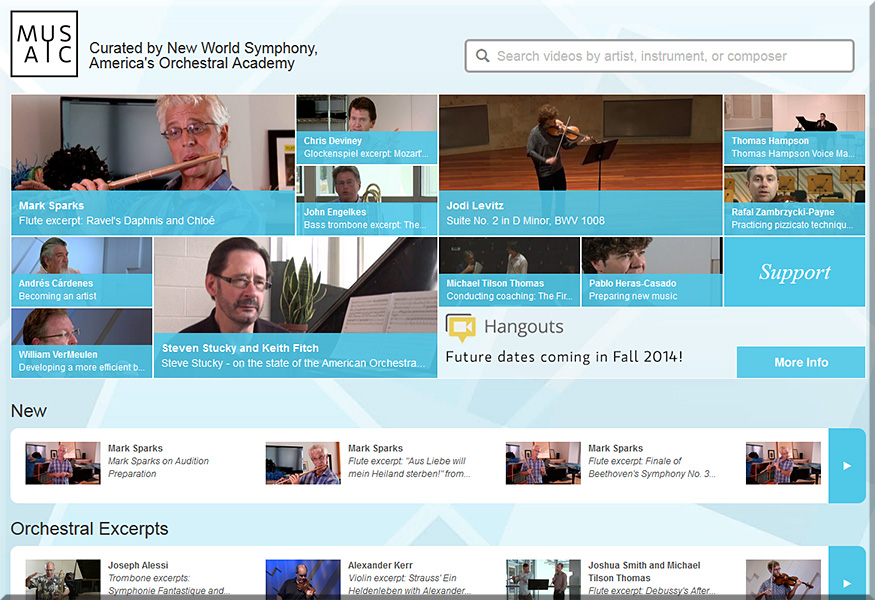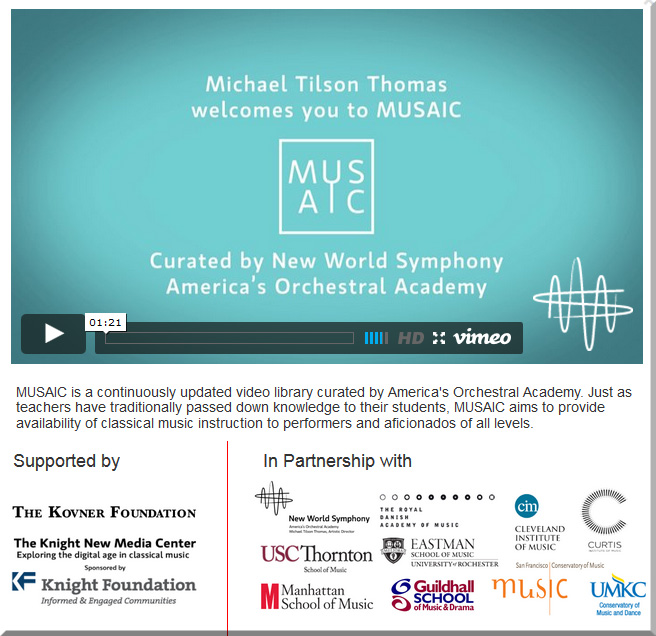Example snapshots from
Microsoft’s Productivity Future Vision




Musaic – A New Treasure Trove of Advice from Music Professionals! — from musicmattersblog.com
Excerpt (emphasis DSC):
As I’ve attended music teacher workshops and conferences over the years, one of the highlights has always been attending master classes. I love watching other teachers interact with students and gleaning insights that I can utilize in my own teaching. Musaic – an initiative of New World Symphony – seeks to bring masterclasses and dozens of other videos from professional musicians right to your fingertips! In addition to masterclasses, you can view a growing collection of performances, tips, and how-to videos that will prove beneficial to music teachers and students alike. What a great project!
Also see:
Living social: How second screens are helping TV make fans — from nielsensocial.com
Excerpt (emphasis DSC):
Television viewing used to be an experience strictly between viewer and show, with water cooler talk coming the day after. The rise of social TV has changed that relationship, and according to a study by Nielsen, more and more Americans are quickly warming up to this new behavior. With tablets, smartphones and laptops at their side, TV viewers can follow their favorite shows, share content and connect with fellow fans before, during and after a program.
From DSC:
Instead of TV/entertainment-oriented programs, how about a service that offers cloud-based, scaffolded streams of content that are more educational/training-related in nature, complete with digital playlists of interactive content that can be offered up on the main display, while lifelong learners interact and discuss the content via their PLNs, cohorted groups of learners within their learning hubs, etc.?
![The Living [Class] Room -- by Daniel Christian -- July 2012 -- a second device used in conjunction with a Smart/Connected TV](http://danielschristian.com/learning-ecosystems/wp-content/uploads/2012/07/The-Living-Class-Room-Daniel-S-Christian-July-2012.jpg)
C-Suite TV debuts, offers advice for the boardroom — from streamingmedia.com by Troy Dreier
Business leaders now have an on-demand video network to call their own, thanks to one Bloomberg host’s online venture.
Excerpt:
Bringing some business acumen to the world of online video, C-Suite TV is launching today. Created by Bloomberg TV host and author Jeffrey Hayzlett, the on-demand video network offers interviews with and shows about business execs. It promises inside information on business trends and the discussions taking place in the biggest boardrooms.
The Future of TV is here for the C-Suite — from hayzlett.com by Jeffrey Hayzlett
Excerpt:
Rather than wait for networks or try and gain traction through the thousands of cat videos, we went out and built our own network.
See also:
From DSC:
The above items took me back to the concept of Learning from the Living [Class] Room.
Many of the following bullet points are already happening — but what I’m trying to influence/suggest is to bring all of them together in a powerful, global, 24 x 7 x 365, learning ecosystem:
…then I’d say we’ll have a powerful, engaging, responsive, global education platform.
CONTENTS
Some excerpts from this report:
Good content should be matched by good content discovery , including recommendations. The current state-of -the-art is defined by Netflix.
…
Today’s TV experience is worlds apart from the one we were talking about even five years ago. We’ve witnessed exponential growth in services such as HD and have moved from a model in which one screen is watched by many, to many screens (and devices) being available to the individual viewer, what is today called TV Everywhere. Having multiscreen access to content is driving the demand for a more personalised experience, in which the viewer can expect to see what they want, where, and when. While video on-demand (VOD) has been a great method for delivering compelling content to viewers, it is not always a truly seamless TV-like experience, and traditionally has been limited to the living room. The growing demand for the personalised experience is driving seismic change within the TV industry, and we’ve seen great strides made already, with time-shifted TV and nPVR as just two examples of how we in the industry can deliver content in the ways viewers want to watch. The next step is to move towards more advanced content discovery, effectively creating a personalised channel or playlist for the individual user.
…
As the tools become available to deliver personalized experiences to consumers, content owners can better create experiences that leverage their content. For example, for sports with multiple points of action, like motor racing, multiple camera angles and audio feeds will allow fans to follow the action that is relevant to their favourite racing team. And for movies, access to additional elements such as director’s commentaries, which have been available on Blu-ray discs for some time, can be made available over broadcast networks.
From DSC:
Some words and phrases that come to my mind:
![The Living [Class] Room -- by Daniel Christian -- July 2012 -- a second device used in conjunction with a Smart/Connected TV](http://danielschristian.com/learning-ecosystems/wp-content/uploads/2012/07/The-Living-Class-Room-Daniel-S-Christian-July-2012.jpg)

TVs are becoming the next app battleground — from by Emily Adler
Excerpt:
The app store phenomenon, centered on smartphones and tablets, has been the biggest story in software for the past five years.
Its next logical destination: the living room, via smart TVs and set-top boxes connected to the Internet.
…
From DSC:
![The Living [Class] Room -- by Daniel Christian -- July 2012 -- a second device used in conjunction with a Smart/Connected TV](http://danielschristian.com/learning-ecosystems/wp-content/uploads/2012/07/The-Living-Class-Room-Daniel-S-Christian-July-2012.jpg)

Addendum/also see:
The connected TV landscape: Why smart TVs and streaming gadgets are conquering the living room — from businessinsider.com.au by Mark Hoelzel
In the connected TV world, an app is analogous to a TV channel.
Some key points:
From DSC:
If in a connected TV world, an app is analogous to a TV channel…then I say let’s bring on the educationally-related, interactive, multimedia-based apps!
![The Living [Class] Room -- by Daniel Christian -- July 2012 -- a second device used in conjunction with a Smart/Connected TV](http://danielschristian.com/learning-ecosystems/wp-content/uploads/2012/07/The-Living-Class-Room-Daniel-S-Christian-July-2012.jpg)
The Campus of the Future: Hybrid and Lean — from edcetera.rafter.com by Kirsten Winkler
Excerpt:
When people imagine the campus of the future, two main ideas seem to come up. On the one hand, the campus experience will be blended or hybrid, meaning that even with the majority of learning taking place online, there will still be demand for activities in a classic brick-and-mortar setting. On the other hand, the campus of the future will be more like a technology startup, focused on cutting expenses and running a lean operation.
Three recent articles in Education DIVE, The Times Higher Education, Slate and Inc. underline this trend.
The above article links to:
Internet mentors could supplant traditional lecturers — from timeshighereducation.co.uk by Jack Grove
Horizon Scanning study points to a ‘new kind of pedagogy’ in higher education by 2020
Excerpt:
Traditional lecturers may soon be replaced by networks of online mentors working for several universities, a new study predicts.
In the report, titled Horizon Scanning: What will higher education look like in 2020?, the Observatory on Borderless Education suggests that academic staff are likely to be employed part-time by several universities – often working remotely via the internet – rather than relying on a single employer.
…
With one undergraduate module, Forms of Identity, already taught via video conferencing to students at both institutions, the alliance “may be pointing the way to a new kind of pedagogy”, the report says.
“Undergraduate lectures, for example, may be delivered simultaneously to any number of participating institutions, either across a whole sector or indeed across borders,” it states.
From DSC:
With adjunct faculty members playing a significant role at many institutions of higher education, I could see a scenario like this occurring. In fact, even years ago I knew an adjunct faculty member who sat behind her PC all day, servicing students at multiple universities. I’m sure that this is not a rare occurrence. Plus, we are already above 30% of the workforce working in a freelance mode, with estimations of this going to 40% or more by 2020.
Learning hubs: (how I define it)
Places of blended/hybrid learning whereby some of the content is “piped in” or made available via the Internet and whereby some of the content is discussed/worked on in a face-to-face manner.

Questions:
Last comment:
The first School in the Cloud opens in the UK — from blog.ted.com by Sarah Schoengold; with thanks to Lisa Duty (@LisaDuty1) for posting this resource on Twitter

A group of students explores a question at the Killingworth School in the Cloud,
as a volunteer member of the “Granny Cloud” gives them guidance from the screen.
…
“SOLE” –> Stands for “Self-Organized Learning Environment.”
Excerpt:
Sugata Mitra has opened the doors of the world’s first School in the Cloud.
Located inside George Stephenson High School in Killingworth, England, this one-room learning lab is a space where students can embark on their own learning adventures, exploring whatever questions most intrigue them. Students even designed the interior of the space — which has colorful beanbags scattered throughout and (very appropriately) fluffy clouds painted on the walls.
…
The Killingworth School in the Cloud is run by a committee of 12-year-old students, who manage a schedule to let different classes and groups use the lab in time slots before, during and after school.
Also see:
Also see:
![The Living [Class] Room -- by Daniel Christian -- July 2012 -- a second device used in conjunction with a Smart/Connected TV](http://danielschristian.com/learning-ecosystems/wp-content/uploads/2012/07/The-Living-Class-Room-Daniel-S-Christian-July-2012.jpg)
Addendum:

Top 10 Characteristics of a 21st Century Classroom
Excerpt:
As education advances with the help of technology, it becomes very clear that the modern day classroom needs are very different from the conventional classroom needs.
The evolved 21st century classroom is a productive environment in which students can develop the skills they will require in the workplace and teachers are facilitators of their learning. The focus of a 21st century classroom is on students experiencing the environment they will enter as modern day workers and developing their higher order thinking skills, effective communication skills, collaboration skills, making them adept with using technology and all other skills that they will need in the 21st century workplace.
Learning in ‘the Living [Class] Room’
From campustechnology.com by Mary Grush and Daniel Christian
Convergent technologies have the ability to support streams of low-cost, personalized content, both at home and in college.

“The main obstacle to an Apple television set has been content. It has mostly failed to convince cable companies to make their programming available through an Apple device. And cable companies have sought to prevent individual networks from signing distribution deals with Apple.”
— Apple, closer to its vision for a TV set, wants
ESPN, HBO, Viacom, and others to come along
qz.com by Seward, Chon, & Delaney, 8/22/13
From DSC:
I wonder if this is because of the type of content that Apple is asking for. Instead of entertainment-oriented content, what if the content were more focused on engaging, interactive, learning materials? More on educational streams of content (whether we — as individuals — create and contribute that content or whether businesses do)?
Also see:
Excerpt (emphasis DSC):
The communications landscape has historically taken the form of a tumultuous ocean of opportunities. Like rolling waves on a shore, these opportunities are often strong and powerful – yet ebb and flow with time.
Get ready, because the next great wave is upon us. And, like a tropical storm, it is likely to change the landscape around us.
As detailed by analyst Chetan Sharma, this particular wave is the one created by the popularity of over-the-top (OTT) solutions – apps that allow access to entertainment, communication and collaboration over the Internet from smartphones, tablets and laptops, rather than traditional telecommunications methods. Sharma has coined this the mobile “fourth wave” – the first three being voice, messaging (SMS) and data access, respectively – and it is rapidly washing over us.
Addendum on 11/25:

Excerpts (emphasis DSC):
For the first time, IBM will open up Watson as a development platform in the Cloud to spur innovation and fuel a new ecosystem of entrepreneurial software app providers who will bring forward a new generation of applications infused with Watson’s cognitive computing intelligence.
…
The Watson Ecosystem empowers development of “Powered by IBM Watson” applications. Partners are building a community of organizations who share a vision for shaping the future of their industry through the power of cognitive computing. IBM’s cognitive computing cloud platform will help drive innovation and creative solutions to some of life’s most challenging problems. The ecosystem combines business partners’ experience, offerings, domain knowledge and presence with IBM’s technology, tools, brand, and marketing.
Learning from the Living [Class] Room — from Campus Technology by Daniel Christian and Mary Grush; with a huge thanks also going out to Mr. Steven Niedzielski (@Marketing4pt0) and to Mr. Sam Beckett (@SamJohnBeck) for their assistance and some of the graphics used in making these videos.
From DSC:
These 4 short videos explain what I’m trying to relay with a vision I’m entitling, Learning from the Living [Class] Room. I’ve been pulse checking a variety of areas for years now, and the pieces of this vision continue to come into fruition. This is what I see Massive Open Online Courses (MOOCs) morphing into (though there may be other directions/offshoots that they go in as well).
After watching these videos, I think you will see why I think we must move to a team–based approach.
(It looks like the production folks for Campus Technology had to scale things way back in terms of video quality to insure an overall better performance for the digitally-based magazine.)
To watch these videos in a higher resolution, please use these links:
Alternatively, these videos can be found at:
.
Smart Machines: IBM’S Watson and the era of cognitive computing — from cup.columbia.edu by John E. Kelly III, Director of IBM Research, and Steve Hamm, writer at IBM and former business and technology journalist
Excerpt (emphasis DSC):
Computers today are brilliant idiots. They have tremendous capacities for storing information and performing numerical calculations-far superior to those of any human. Yet when it comes to another class of skills, the capacities for understanding, learning, adapting, and interacting, computers are woefully inferior to humans; there are many situations where computers can’t do a lot to help us.
…
But the goal is not to replicate human brains or replace human thinking with machine thinking. Rather, in the era of cognitive systems, humans and machines will collaborate to produce better results, each bringing its own skills to the partnership. The machines will be more rational and analytic-and, of course, possess encyclopedic memories and tremendous computational abilities. People will provide judgment, intuition, empathy, a moral compass, and human creativity.
From DSC:
Consider what Watson “read in” to come up with some recommendations:

Addendum on 10/14/13 (emphasis DSC):
Watson is being used to assist with the treatment of cancer patients. According to an article from medicalnewstoday.com, Watson is “revolutionizing cancer care and research and speeding up progress for patients.”
In that same article, it mentions that, so far, Watson has ingested:
One of IBM’s General Managers who works with Watson said:
“breakthrough capabilities bring forward the first in a series of Watson-based technologies, which exemplifies the value of applying big data and analytics and cognitive computing to tackle the industry’s most pressing challenges.”
True personalization is the next big thing in multiscreen TV — from .v-net.tv by John Moulding

From DSC:
Not a far stretch to see some applications of this in the future aimed at learning objects/learning agents/and personalized streams of content.
![The Living [Class] Room -- by Daniel Christian -- July 2012 -- a second device used in conjunction with a Smart/Connected TV](http://danielschristian.com/learning-ecosystems/wp-content/uploads/2012/07/The-Living-Class-Room-Daniel-S-Christian-July-2012.jpg)
Addendum:
(With thanks going out to Mr. Richard Byrne over at the Free Technology for Teachers blog for this item)

